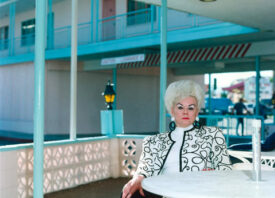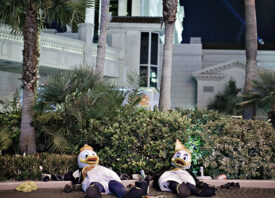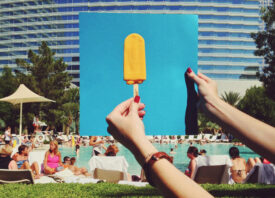Search this site
Sin City: Las Vegas Photography, Through the Decades

Geoffrey Ellis captures the spirit of Las Vegas in the 1970s and 80s, while Markus Altmann photographs the city in the 1990s. Meanwhile, Stephanie Diani introduces us to the legends of burlesque, while Stefanie Moshammer shows us why Vegas is known as the “strip club capital of the world.” In this collection of Las Vegas photography, six photographers document Sin City, then and now.

Markus Altmann’s Fascinating Las Vegas Photography From 1995
“Shot in 1995, Las Vegas 95 is the photographer Markus Altmann‘s look at sin city in the midst of its transformation from an old gambling town to a family entertainment metropolis, stacked high with mega hotels and theme parks. Intrigued by the aesthetics of the newly constructed facades and how they relate to the seemingly more authentic realities of the older surroundings, Altmann weaves together surreal, almost otherworldly shots that give off the feel they are at once set in the past and future.”

Stefanie Moshammer’s Portraits From the Strip Club Capital of the World
“When Stefanie Moshammer visited Las Vegas for two months, her days weren’t spent sunbathing by the pool at Caesars Palace or hitting the Bellagio casino at night. The Austrian photographer had a different motive in mind. Fascinated by the lifestyle of those who exist behind the shiny façade of sin city, she set out to document Las Vegas strippers and the hotel rooms, pink Cadillacs, and nightclubs that act as their stage. The resulting series, Vegas and She, depicts the Las Vegas we don’t see.”

Geoffrey Ellis Channels the Debauched Spirit of the 1970s-80s in His Las Vegas Photography
“Valley of the Meadows the photographer Geoffrey Ellis‘s depiction of the Las Vegas that existed in the 1970s and 80s, a time when he says ‘the city was in a depressing downward spiral and the criminal entities running the city were slowly losing their grip.’ This is the Vegas that was sandwiched between the Hollywood-esque days of high rollers and The Rat Pack in the 1950s and 60s and the transition in the 1990s and 2000s into ‘a family friendly destination which ultimately became a type of adult Disneyland.’
“Ellis presents a collection of images that we feel compelled to piece together, lingering like clues to a larger reveal and resonating with a tension and darkness akin to this mythic land of opportunity ‘where the extremes of luxury and vice are out in the open and the lure of promise draws one in.'”

Christian Lutz Documents the Hardship of Las Vegas During a Time of Crisis
The photographer Christian Lutz found himself in the city at the height of our most recent financial crisis. He spent three consecutive summers documenting the streets beneath the neon lights.
In his book, Insert Coins, Lutz bears witness to the wreckage of The City of Lights, and he seems to do so with an incorruptible poker face. It’s a requiem for all the promises Las Vegas made and broke a thousand times over. The book is also about something more, about the ways in which we all hope against hope that fortune will turn our way, even when she’s turned her back on us so many times before.

Stephanie Diani Photographs Burlesque Stars in Her Las Vegas Photography
“For her series Dames: The Legends of Burlesque, New-York based photographer Stephanie Diani photographed older dancers wearing costumes that were significant or special to them. The ladies are portrayed in their homes or in the hotel rooms where they stayed in the past while performing in Las Vegas. Their personalities differ, but what they all have in common are grace, courage, and self-possession.”

Harry Gruyaert’s Photos Take Us On a Colorful Journey to Vegas and Beyond
“In 1981, Geo photo editor Alice Rose George commissioned Henry Gruyaert to photograph Las Vegas. Rather than provide his take on the tired tropes of the Strip, Gruyaert ventured off the beaten path to the Vegas where residents lived. The result was entirely too realistic; Vegas was not the place of fantasies and spectacle – it was a world where people eked out their existence on the margins.”



